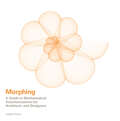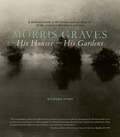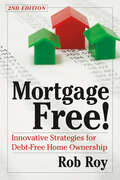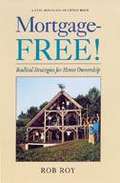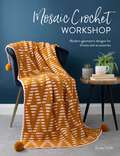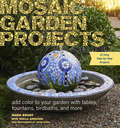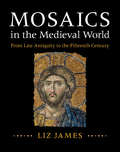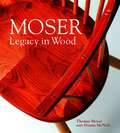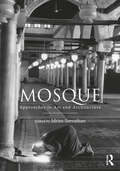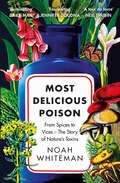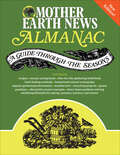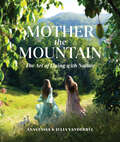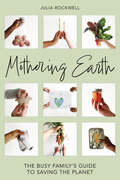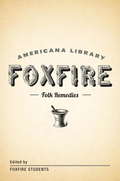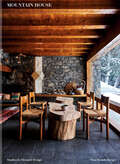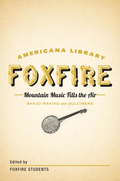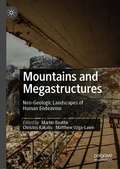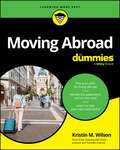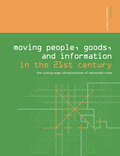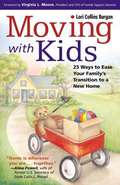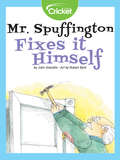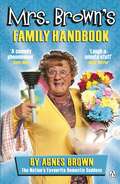- Table View
- List View
Morphing: A Guide To Mathematical Transformations For Architects And Designers
by Joseph ChomaCylinders, spheres and cubes are a small handful of shapes that can be defined by a single word. However, most shapes cannot be found in a dictionary. They belong to an alternative plastic world defined by trigonometry: a mathematical world where all shapes can be described under one systematic language and where any shape can transform into another.This visually striking guidebook clearly and systematically lays out the basic foundation for using these mathematical transformations as design tools. It is intended for architects, designers, and anyone with the curiosity to understand the link between shapes and the equations behind them.
Morphing: A Guide to Mathematical Transformations for Architects, Designers
by Joseph ChomaCylinders, spheres and cubes are a small handful of shapes that can be defined by a single word. However, most shapes cannot be found in a dictionary. They belong to an alternative plastic world defined by trigonometry: a mathematical world where all shapes can be described under one systematic language and where any shape can transform into another.This visually striking guidebook clearly and systematically lays out the basic foundation for using these mathematical transformations as design tools. It is intended for architects, designers, and anyone with the curiosity to understand the link between shapes and the equations behind them.
Morris Graves: His Houses, His Gardens
by Richard SvareAuthor Svare tells the compelling story of the creation and renovation of residences that were home to Morris Graves, a leading figure in Northwest Art and one of the most important American artists of the twentieth century. This insightful rendering contains never before published photographs and a captivatingnarrative.
Mortgage Free!: Innovative Strategies for Debt-Free Home Ownership, 2nd Edition
by Robert L. Roymort•gage (mor´-gij)n. from Old French morgage, mort gage, literally &“death pledge&”As a wave of foreclosures sweeps the country, many people are giving up hope for owning a home of their own. They have good reason to turn their backs on the banks, but not on their dreams. In this revised edition of Mortgage Free!, Rob Roy offers a series of escape routes from enslavement to financial institutions, underscored by true stories of intrepid homeowners who have put their principles into action.From back-to-the-land homesteads to country homes, here is a complete guide to strategies that allow you to own your land and home, free and clear, without the bank. Included is detailed advice about:Clarifying and simplifying your notions of what&’s necessaryFinding land that you love and can affordTaking control of the house-building process, for the sake of sanity and pleasureLearning to take a long-term perspective on your family&’s crucial economic decisions, avoiding debt and modern-day serfdom
Mortgage-Free!: Radical Strategies for Home Ownership
by Rob RoyExplains clearly how if you have a mortgage already you can maximize your equity sooner and save tons of money.
Mosaic Crochet Workshop: Modern geomretric designs for throws and accessories
by Esme CrickCreate beautiful mosaic crochet throws and accessories with this indispensable guide featuring sensational geometric designs.Mosaic crochet is a cutting-edge technique that allows you to work two-color patterns without having to change yarns in one row. You simply skip stitches in one row and connect them by filling in with the alternate color two rows later. This produces incredible modern geometric patterns that look amazing as throws, blankets, afghans, pillows, rugs, bags and other accessories. One crochet hook and two balls of yarn are all you need to get started.In Mosaic Crochet Workshop, crochet designer Esme Crick shows you how to make twelve bold, statement throws. She also includes twelve spin-off designs for smaller projects that demonstrate how a single pattern can create completely different results depending on your choice of colors. With full step-by-step guidance on the mosaic stitch, charts for all the mosaic crochet patterns, and twenty-four projects with full written patterns, this stylish crochet book will change the way you approach color-work and give you a wealth of beautiful throws and accessories.
Mosaic Garden Projects: Add Color to Your Garden with Tables, Fountains, Bird Baths, and More
by Mark Brody Sheila Ashdown“This thorough guide to techniques, tools, and materials is filled with expert tips and tricks. The detailed project instructions will inspire you to make your own mosaicked mark on the landscape.” —Lorene Edwards Forkner, author of Handmade Garden Projects In Mosaic Garden Projects, artist Mark Brody walks step-by-step through the creation of 25 decorative yet functional projects. With simple ideas like address signs and stepping stones to more complex projects such as an orb fountain, Brody also includes with a primer on the fundamentals of mosaic and information on the range of possible materials. Project templates are included along with instructions on how to scale each project. Mosaic Garden Projects is packed with inspiration that will brighten the garden all year long.
Mosaics in the Medieval World: From Late Antiquity to the Fifteenth Century
by Liz JamesIn this book, Liz James offers a comprehensive history of wall mosaics produced in the European and Islamic middle ages. Taking into account a wide range of issues, including style and iconography, technique and material, and function and patronage, she examines mosaics within their historical context. She asks why the mosaic was such a popular medium and considers how mosaics work as historical 'documents' that tell us about attitudes and beliefs in the medieval world. The book is divided into two part. Part I explores the technical aspects of mosaics, including glass production, labour and materials, and costs. In Part II, James provides a chronological history of mosaics, charting the low and high points of mosaic art up until its abrupt end in the late middle ages. Written in a clear and engaging style, her book will serve as an essential resource for scholars and students of medieval mosaics.
Moser: Legacy in Wood
by Thomas F. Moser Donna McNeilThos. Moser Cabinetmakers has set the standard for fine woodworking and meticulously hand-crafted furniture for more than forty years. In this modern age of inexpensive mass production, Moser furniture stands out because every piece is hand-made by a master craftsman (or woman). Generally minimalist in style, the pieces are highly sophisticated in their construction. And though Moser has been influenced by Shaker and Japanese furniture makers, the elegant and graceful lines give each piece an aesthetic all its own.In Legacy in Wood, Thomas Moser reflects on his long career and offers his thoughts on creativity, inspiration, and his design aesthetic. It gives an intimate look into the life and work of a pioneering craftsman, whose example shows that you can build a career working with your hands the old-fashioned way.Thos. Moser remains an iconic Maine company and holds to its traditional Yankee origins. The shop remains a family-run and oriented company. All of Moser&’s sons have worked in the shop, and all but one are still there as master craftsmen and designers. The other employees have been with the company an average of 20 years—a clear reflection of the value Moser puts on his workers and the respect and love for their work they give in return. Yet the timeless appeal of the furniture has given Moser nationwide recognition and allowed the company to open galleries and show rooms in Boston, Greenwich, New York, Philadelphia, and San Francisco.
Mosque: Approaches to Art and Architecture
by Idries TrevathanMosque examines the history, culture, evolution and functions of the Muslim house of worship through the prism of its artistic objects and architectural elements. Contributors present a range of elements, from dome to mihrab, to mosque furniture including lamps, prayer rugs and Qur’an stands. In addition, the book draws attention to the importance of mosque heritage through special projects and initiatives that study, preserve and revitalize the traditional arts of the mosque. This unique book brings together prominent architects, art historians, artists, historians and curators to explore innovative approaches towards the study of mosques through the presentation of original research and insights about mosque-related cultural objects. It is essential reading for anyone interested in the art and culture of the Muslim world.
Most Delicious Poison: From Spices to Vices – The Story of Nature's Toxins
by Noah WhitemanA deadly secret lurks within our kitchens, medicine cabinets and gardens... Digitalis purpurea. The common foxglove. Vision blurs as blood pressure drops precipitously. The heartbeat slows until, finally, it stops. Atropa belladonna. Deadly nightshade. Eyes darken as strange shapes flutter across your vision. The heart begins to race and soon the entire body is overcome with convulsions. Papaver somniferum. The opium poppy. Pupils constrict to a pinprick as the senses dull. Gradually, breathing shudders to a halt. Scratch the surface of a coffee bean, a chilli flake or an apple seed and find a bevy of strange chemicals – biological weapons in a war raging unseen. Here, beetles, birds, bats and butterflies must navigate a minefield of specialised chemicals and biotoxins, each designed to maim and kill. And yet these chemicals, evolved to repel marauding insects and animals, have now become an integral part of our everyday lives. Some we use to greet our days (caffeine) and titillate our tongues (capsaicin), others to bend our minds (psilocybin) and take away our pains (opioids). Informed by his father&’s love of the natural world and his eventual spiral into the depths of addiction, evolutionary biologist Noah Whiteman explores how we came to use – and abuse – these chemicals. Delving into the mysterious origins of plant and fungal toxins, and their unique human history, Most Delicious Poison provides a kaleidoscopic tour of nature&’s most delectable and dangerous poisons. ***** 'Deeply researched and fascinating.' —JENNIFER DOUDNA, WINNER OF THE NOBEL PRIZE IN CHEMISTRY 'Magisterial, fascinating and gripping.' —NEIL SHUBIN, AUTHOR OF YOUR INNER FISH 'Exuberant, poignant and mind-blowing.' —DANIEL E. LIEBERMAN, AUTHOR OF EXERCISED
Mother Earth News Almanac: A Guide Through the Seasons
by Mother Earth News“A great resource for both professional and amateur gardeners. . . . This book provides hundreds of useful tips in a very easy, readable language and style.” —The Washington Book ReviewMother Earth News Almanac is back—refreshed and ready for the next generation of self-sufficient makers and DIYers. The 1970s classic has been updated for today’s readers, its information is as useful as ever. Containing instructions and illustrations for everything from harnessing solar energy to cultivating a sustainable garden to learning how to keep bees, Mother Earth News Almanac is designed to empower readers to be self-sufficient. With all the charm of the original—from the writing style to the signature line drawings, this budget-friendly guide is a must-have for any fan of Mother Earth News. Organized by season, the guide contains recipes, money-saving tips, and homesteading techniques such as illustrated directions for tying a timber hitch, cat’s-paw, sheepshank, and other knots; folk medicine treatments and preventatives; tips on raising chickens and keeping bees; plans for building three kinds of kites; complete instructions for fast and easy compost; and much, much more! The simple life doesn’t have to be hard—not when you have this timeless almanac.
Mother the Mountain: The Art of Living with Nature
by Julia Vanderbyl Anastasia VanderbylAn inspiring and transformative book of hope that reveals how to heal the earth and ourselves in the process.As young women, sisters Anastasia and Julia Vanderbyl began a compelling journey of restoration deep in the Australian rainforest. A beautifully crafted narrative woven with personal stories, Mother the Mountain is both a memoir of their experiences and a meditation on the extraordinary resilience of nature. In this rich collection of reflections, art, photography, and poetry, you will find yourself enchanted with the wonders of the natural world. Drawing on their life as regenerative farmers, artists, gardeners, and caretakers of both animals and the land, the sisters share secrets of how to deepen your connection with the earth, celebrate creativity, and return to a mindful way of life. A powerful tribute to hope and healing, this book invites you to discover the art of living with nature.
Mothering Earth: The Busy Family's Guide to Saving the Planet
by Julia RockwellThis Earth—and money—saving guide to sustainable living empowers families everywhere to fight climate change by making practical lifestyle changes—at home at their own pace.Expert author Julia Rockwell provides a road map to simplify and streamline our lives in a way that benefits overall well-being and the health of the planet—all without sacrificing comforts or turning our lives upside down. And to do so you...do not need to carve out separate time to focus on sustainability,do not need to spend more money,do not need to partake in DIY projects,do not need to be perfect,do not need to get rid of all the plastic in your home,do not need to turn your family&’s life upside down,do not need to feel guilty (you didn&’t create this mess we are in),do not need to live off the grid.Written and designed to reach all families, this inspiring and useful book highlights &“eco-action&” solutions that support a climate-friendly lifestyle at your own pace. Some of the eco-actions topics covered are:Take a Trash TallyFind Your Free MarketplaceSwitch to ReusablesHelp Kids Eat, Not WasteIt shows us how caring for a healthy planet doesn&’t just boost mental wellness, reduce stress, and heighten sense of community, but also saves time and money, too. Includes a comprehensive list of eco-insider resources, a 31-day Eco-Family Challenge, a guide to creating a personalized roadmap to resources in your area, and the book itself is printed on responsibly forested, FSC certified paper. Realistic yet impactful, Mothering Earth gives readers a feasible guide for simple and meaningful change, while at the same time sparks calmness and connection. With the tools to create an effective and healthy eco-routine, readers take a holistic look at shifting habits and making them stick in this Earth-saving guidebook.&“We know women and girls will be most affected by climate change. Mothering Earth has us all thinking about how to take agency in our own lives while fighting for the systemic changes we need for a thriving planet.&”—Eve Rodsky, author of New York Times bestseller Fair Play and Find Your Unicorn Space"Saving the planet is an all-hands-on-deck effort, and in this book, Julia gives strategies that can get your whole family (or just yourself whilst navigating family) on board with simple shifts that are economical, fun, and best of all, impactful. Every household needs to read this. Better yet, every human needs to read this."—Ashlee Piper, Sustainability Expert and Author of Give A Sh*t: Do Good. Live Better. Save the Planet."This book is a powerful and practical guide for how we can individually make small shifts and daily choices to collectively create a more just, equitable world – and a more climate resilient future – for our children and for generations to come."—Melinda Kramer, Co-Founder and Co-Director of Women&’s Earth Alliance"Conscious parenting is not an easy task, but Julia will show you how it&’s not only possible - it's the foundation for a whole new kind of life. And one that you don&’t want to miss out on."—Anne Therese Gennari, author of The Climate Optimist Handbook"Mothering Earth is the approachable, accessible guide I&’ve needed to move from overwhelm to action. Julia skillfully outlines the small, simple changes my family can make to live more sustainably and create a stronger planet."—Jill Koziol, Co-Founder & CEO, Motherly"Julia has done incredibly thorough research coupled with her dedicated experience and testing in order to offer a wide host of solutions for every aspect of domestic life. This book w
Motherland Herbal: The Story of African Holistic Health
by Stephanie Rose BirdIn this powerful and comprehensive guide in the spirit of Jambalaya and Sacred Woman, an herbalist celebrates ancient and modern African holistic healing.“The message of this book is: hold onto your yams, your collards, watermelon, and roots. There is magic, mystery, connection, and healing stored within them.”—Stephanie Rose BirdStephanie Rose Bird grew up surrounded by forests, listening to the stories of her ancestors and learning African healing ways. From an early age, she dedicated herself to herbalism and living a spiritually fulfilled life in harmony with nature. Now, the wisdom she as accrued is gathered in this impressive encyclopedic work of African Healing and herbal medicine.Stephanie teaches you how to garden and harvest in unison with the seasons, and how to use herbalism and magic—derived from ancestral and spiritual helpers—to heal. A treasure trove of knowledge, Motherland Herbal showcases an array of recipes and rituals that nourish every facet of life:Seasonal recipes to support overall well-beingTinctures for common ailments such as headaches, flu, or heartburnRemedies for improving mental health, lessening symptoms of anxiety, stress, or depressionNatural body and home care products, from facials to cleaning solutionsHerbal Baths for relaxation, sexual wellness, and good luckRituals and Altars for universal experiences, such as learning to letting go after loss and improving creativity and fertilityLove Potions, Sleep Potions, Protective Amulets, and moreWritten in Stephanie’s warm and authoritative voice, Motherland Herbal seamlessly blends activism and ancestral folklore with the realms of spirituality, gardening, and holistic wellness. Her deep reverence for the wisdom of her ancestors infuses every page of this guide, which is a foundational resource that will shape the landscape of African healing and folk medicine for generations to come.Motherland Herbal includes 54 original pieces of art, including maps and artwork created by the author.
Mountain Folk Remedies: The Foxfire Americana Library (9) (The Foxfire Americana Library)
by Inc. Foxfire FundBeginning with an illustrated guide to the herbs and roots used in traditional Appalachian healing, "Mountain Folk Remedies" is a fascinating collection of historic remedies ranging from the practical (burdock tea will help aching feet) to the magical (carrying a buckeye in your pocket will help lessen arthritis).
Mountain House: Studies in Elevated Design
by Nina FreudenbergerA photographic study of more than twenty houses and the mountain landscapes, from alpine forests to urban peaks, that embrace them. Spanning continents and climates, the twenty homes presented in interior designer Nina Freudenberger&’s latest book challenge and expand the idea of what a mountain house might be. Artist retreats in Morocco&’s High Atlas and the snowy folds of the Engadine Valley in Switzerland speak to the long tradition of mountains spaces for contemplation and creation, while modernist masterworks in Cape Town and Rio de Janeiro expand the traditional image of log cabins and rustic chalets. Depicted in over 200 images, these houses include brutalist lodges, clapboard cottages, and minimalist prisms set down among some of the world&’s most dramatic landscapes. In their spectacular diversity, they express the radical ingenuity and stunning creativity that the mountains have always inspired.
Mountain Music Fills the Air: The Foxfire Americana Libray (11) (The Foxfire Americana Library)
by Inc. Foxfire FundBanjos and dulcimers have always been an essential part of Appalachian music, shared and enjoyed throughout the generations. Here, musicians share the history of the instruments and show how they are constructed, piece by piece, with photos and diagrams.
Mountains and Megastructures: Neo-Geologic Landscapes of Human Endeavour
by Christos Kakalis Martin Beattie Matthew Ozga-LawnThis book explores the shared qualities of mountains as naturally-formed landscapes, and of megastructures as manmade landscapes, seeking to unravel how each can be understood as an open system of complex network relationships (human, natural and artificial). By looking at mountains and megastructures in an interchangeable way, the book negotiates the fixed boundaries of natural and artificial worlds, to suggest a more complex relationship between landscape and architecture. It suggests an ecological understanding of the interconnectedness of architecture and landscape, and an entangled network of relations. Urban, colonialist, fictional, rural and historical landscapes are interwoven into this fabric that also involves discontinuities, tensions and conflicts as parts of a system that is never linear, but rather fluid and organic as driven by human endeavor.
Move Your Stuff, Change Your Life: How to Use Feng Shui to Get Love, Money, Respect and Happiness
by Karen Rauch CarterAn essential and accessible guide to increasing happiness, improving your financial well-being, and bettering your health through the timeless Chinese art of feng shui.Promising health, wealth, and happiness, feng shui offers endless appeal—at least in concept. Unfortunately, feng shui&’s seemingly complicated methods are often difficult to learn and apply in a meaningful way. Fortunately, Move Your Stuff, Change Your Life is written in plain and simple English for the modern Western reader. Revealing the ancient Chinese secrets that are as useful and necessary today as they have been for centuries, Move Your Stuff, Change Your Life communicates how to: · MEET &“THE ONE&” · FIND A DREAM JOB · EARN BETTER GRADES IN SCHOOL · ENJOY A BETTER SEX LIFE
Moving Abroad For Dummies
by Kristin M. WilsonExpert guidance for anyone who wants to settle down in another country Moving Abroad For Dummies is for anyone contemplating pulling the trigger on moving out of their homeland for a short time or for good. Be it to enhance a career, retire more comfortably on savings, or find a culture that's a better fit for you, relocating abroad takes some planning to be done right. This book walks you through all the considerations and the steps you'll need to take to make it happen. Author Kristin Wilson is a relocation expert with over 20 years of experience both living abroad and helping hundreds of others do the same. In this confusion-clearing guide, she offers must-know information on planning a move, getting affairs in order before hitting the road, and settling into your new home. Find out whether becoming an expat is the right move for you Learn how to budget for your new life, find a home abroad, and handle culture shock Become a permanent resident of your new country of choice Decide whether and when to return home At every stage of the moving abroad process—decision making, preparation, and adjustment to a new culture—this clear and easy-to-read Dummies guide has your back.
Moving People, Goods and Information in the 21st Century: The Cutting-Edge Infrastructures of Networked Cities (Networked Cities Series)
by Richard E HanleyGlobalisation and technological innovation have changed the way people, goods, and information move through and about cities. To remain, or become, economically and environmentally sustainable, cities and their regions must adapt to these changes by creating cutting-edge infrastructures that integrate advanced technologies, communications, and multiple modes of transportation. The book defines cutting-edge infrastructures, details their importance to cities and their regions, and addresses the obstacles to creating those infrastructures.
Moving with Kids: 25 Ways to Ease Your Family's Transition to a New Home
by Lori Collins Burgan Virginia L. MasonThirteen million children in the U. S. each year leave behind familiar people and places to move to new homes across town and across the country. Moving can be hard for parents too, as they not must not only prepare themselves but also help their children cope with the changes. In Moving with Kids, social worker and mother of three Lori Collins Burgan offers 25 practical, action-oriented tips for parents before, during, and after a move. Tips include giving kids a sense of control and involvement in the move, making the physical move less stressful, and creating a sense of belonging in a new home. Written with busy parents in mind, this book is accessible and concise-perfect for anyone looking to help children adjust to a move.
Mr. Spuffington Fixes It Himself
by John GranditsMr. Spuffington and his cat, Pablo, are trying to fix the sticky bathroom door when Mr. Spuffington drops his hammer and breaks the sink. Maybe home improvement just isn’t for him! After trying to do the repairs himself, he realizes he needs some help. Can a helpful handyman save the day?
Mrs Brown's Family Handbook
by Brendan O'CarrollUncover hilarious and unique insights into the Brown family, in Brendan O'Carroll's first official book on his NTA winning comic creation Mrs Brown's Boys.Millions od us have wondered: how does Agnes Brown do it? Keeping her end up while seven grown-up children tear about the fecking place like the eejits don't have a home to go to.Packed with Mammy's tips for keeping a perfect family - or at least, just a family - as well as contributions from her children, neighbours and other hangers on, Mrs Brown's Family Handbook dispenses endless advice in her fecking fantastic style.You'll learn: Why every mammy's secret weapon is the tea towel The dos and don'ts of cleaning up Granddad What Dermot doesn't know about farting (not much) What Winnie knows about seks (not enough) All about the Five-Sausages-A-Day Diet (hint: contains sausages) From Maria, all about pain relief in child birth (if it's free, fecking take it)The must-have gift for any Mrs Brown fan, Mrs Brown's Family Handbook is perfect for equally large and chaotic families, or those in small families curious about what they're missing...Brendan O'Carroll is an Irish writer, producer, comedian, actor, director and author. He is best known for playing Agnes Brown in Mrs Brown's Boys, which won the best sitcom BAFTA in 2012 and best comedy at the National Television Awards 2020. He has written four films and nine comedy shows, including The Course (1995) and The Last Wedding (1999). He has also published seven novels, including The Mammy, The Scrapper and The Young Wan - a number of which have been translated into 12 languages.
